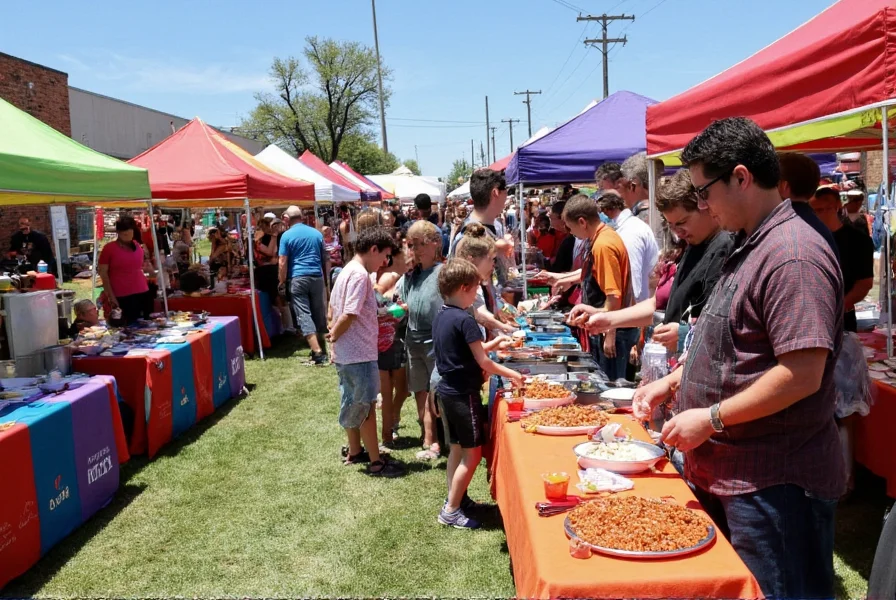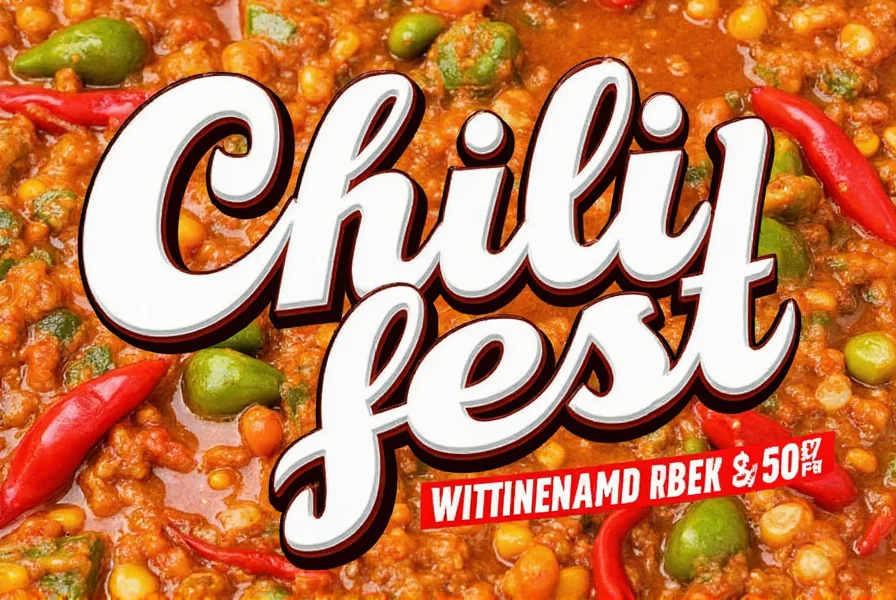Chili festivals represent one of America's most beloved culinary traditions, bringing communities together through shared appreciation for spicy cuisine and regional food culture. These events have evolved from small local gatherings to major cultural celebrations that attract thousands of visitors annually.
The Historical Roots of Chili Festivals
The modern chili fest traces its origins to the 1967 Terlingua International Chili Championship in Texas, which established competitive chili cooking as a legitimate culinary sport. This event emerged from the informal "chili wars" that had been occurring in Texas since the late 19th century, where cowboys and settlers would compete to create the best chili con carne. The sport gained national attention when Texas State Senator Frank 'Shoot-'em-up' Madla declared chili the "official dish of Texas" in 1977, further legitimizing these competitions.
Today's chili festivals maintain these historical traditions while incorporating contemporary elements. Most follow guidelines established by the International Chili Society (ICS), which standardizes competition categories including red chili, verde chili, salsa, and chili dog competitions. The ICS has grown to sanction over 150 events annually across North America, demonstrating the widespread appeal of these festivals.
What Happens at a Typical Chili Festival
Attending a chili fest offers a multi-sensory experience that extends far beyond just tasting spicy food. These events typically feature several key components that create their distinctive atmosphere:
| Festival Component | Description | Visitor Experience |
|---|---|---|
| Chili Competition | Professional and amateur cooks prepare entries according to specific categories | Witness cooking demonstrations and learn about judging criteria |
| Public Tasting Areas | Designated zones where visitors sample various chili recipes | Experience different regional styles and heat levels |
| Entertainment Stages | Live music, cooking demonstrations, and cultural performances | Enjoy regional music and learn cooking techniques from experts |
| Vendor Marketplace | Stalls selling chili-related products, regional crafts, and food items | Discover unique spices, cooking tools, and regional specialties |
One of the most distinctive aspects of chili festivals is the judging process. Professional competitions follow strict protocols where judges evaluate entries based on appearance, aroma, taste, mouthfeel, and aftertaste. The "blind" judging system ensures fairness, with entries identified only by number. Many festivals now include public tasting areas where attendees can sample various entries, creating an inclusive atmosphere that bridges the gap between competitors and visitors.

Regional Variations in Chili Festivals
While chili festivals share common elements, regional variations reflect local culinary traditions and cultural influences. Understanding these differences helps visitors appreciate what makes each event unique:
- Texas-style festivals emphasize meat-forward recipes with minimal beans, focusing on the "bowl of red" tradition that dates back to cattle drive era
- Southwestern festivals often incorporate indigenous ingredients like blue corn and feature verde (green chili) competitions alongside traditional red chili
- Midwestern festivals typically include more bean-based recipes and often feature "chili dog" competitions as a nod to regional fast food traditions
- Coastal festivals sometimes incorporate seafood elements, creating unique fusion dishes that blend traditional chili with local marine ingredients
These regional distinctions make searching for "chili festival events near me" particularly valuable, as local festivals often highlight ingredients and cooking methods specific to the area. Many communities have developed signature styles that reflect their cultural heritage, making each festival a celebration of local identity as much as culinary skill.
How to Find and Enjoy Chili Festivals
With hundreds of chili festivals occurring annually across North America, finding events that match your interests requires some planning. The International Chili Society maintains a comprehensive calendar of sanctioned events, while regional tourism boards often highlight local festivals as part of their culinary tourism initiatives.
For first-time attendees, understanding what to expect at a chili fest enhances the experience significantly. Most festivals operate on a weekend schedule with competitions typically held early in the day when judges are fresh, followed by public tasting sessions in the afternoon. Many events offer tasting tickets that allow visitors to sample multiple entries without overwhelming their palates.
When planning to attend, consider these practical tips for maximizing your experience:
- Bring cash for tasting tickets and vendor purchases, as many smaller festivals have limited card processing capabilities
- Wear comfortable shoes and clothing appropriate for outdoor events, as most festivals take place in parks or fairgrounds
- Stay hydrated with water between chili tastings to maintain your ability to appreciate different flavors
- Engage with competitors and judges to learn about their techniques and the history behind their recipes
- Check festival websites for specific rules about bringing coolers or outside food, which vary by location
For those interested in participating rather than just attending, many festivals offer amateur competition categories with lower entry barriers. Understanding how chili festivals judge competitions helps potential contestants prepare appropriate entries. Most competitions require specific ingredient lists and prohibit certain additives, with strict rules about presentation and serving temperature.
The Cultural Significance of Chili Festivals
Beyond the food and festivities, chili festivals serve important community functions that explain their enduring popularity. These events create spaces for intergenerational knowledge transfer, where experienced cooks mentor newcomers in traditional techniques. They also function as economic drivers for local communities, with many small towns experiencing significant tourism boosts during festival weekends.
The communal aspect of chili festivals represents their most valuable contribution to American food culture. Unlike many competitive culinary events, chili festivals maintain an atmosphere of camaraderie rather than cutthroat competition. This spirit reflects the historical roots of chili cooking, which originated as a communal food prepared in large quantities for groups of workers and travelers.
As interest in regional American cuisines continues to grow, chili festivals have gained recognition as important cultural events that preserve culinary heritage while adapting to contemporary tastes. Their evolution from simple cook-offs to multifaceted celebrations demonstrates how food traditions can evolve while maintaining their essential character.
What is the difference between a chili festival and a chili cook-off?
A chili cook-off specifically refers to the competitive cooking portion where participants prepare and submit chili for judging. A chili festival encompasses the cook-off plus additional elements like public tastings, entertainment, vendor markets, and educational demonstrations. While all chili festivals include a cook-off, not all cook-offs are part of larger festivals.
How do chili festivals judge the quality of chili entries?
Professional chili competitions use a standardized judging system evaluating five criteria: appearance (20 points), aroma (20 points), taste (40 points), mouthfeel (10 points), and aftertaste (10 points). Judges evaluate entries blind (without knowing the cook's identity) and follow specific protocols to cleanse their palates between samples. Most sanctioned competitions require entries to meet specific ingredient requirements and presentation standards.
Can anyone enter a chili competition at these festivals?
Most chili festivals offer multiple competition categories. While professional divisions may require certification or previous competition experience, nearly all festivals include amateur or backyard categories open to the public. Entry requirements vary by event, but typically involve submitting an entry form, paying a small fee, and following specific preparation guidelines. Many festivals also offer youth categories to encourage the next generation of chili cooks.
What should I bring to a chili festival as an attendee?
Practical items for chili festival attendees include comfortable walking shoes, sunscreen or rain gear depending on the season, cash for tasting tickets and vendor purchases, water to stay hydrated between samples, and a notebook to record favorite recipes or vendors. Some festivals allow small coolers for personal items, but check specific event rules beforehand as policies vary. Bringing a friend enhances the experience as you can share tastings and explore different areas of the festival together.
Are chili festivals family-friendly events?
Yes, most chili festivals are designed to be family-friendly community events. They typically include designated children's areas with activities, milder food options for younger palates, and entertainment suitable for all ages. Many festivals specifically promote their family-friendly atmosphere as part of their community mission. However, as with any public event, parents should supervise children, especially around cooking areas and crowded spaces.











 浙公网安备
33010002000092号
浙公网安备
33010002000092号 浙B2-20120091-4
浙B2-20120091-4